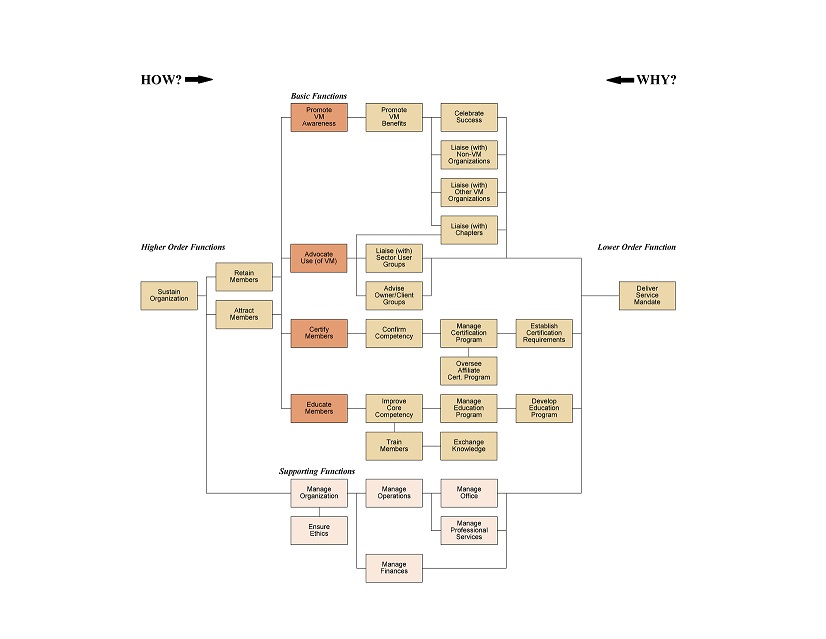By David C. Wilson, PEng, CVS-Life, FSAVE, CPF
PACE, or more appropriately the PACE Initiative, is the moniker given to the defining structural management model that SAVE International has adopted to deliver its operational mandate. I am always surprised when I speak with value professionals, even some seasoned veterans in the industry or those involved in the management of SAVE, that don’t really understand what PACE is about and, more importantly, how PACE is focused on – not just SAVE, but the health of the value industry.
Okay, so I’m a bit bewildered. So what? Who am I to be waxing on about PACE anyways? Good questions! Maybe I need to start over…you know, at the beginning.
First things first. PACE is an acronym for Promote VM Awareness, Advocate Use of VM, Certify Members, and Educate Members. These are the basic functions of the organization. Simple as that.
The genesis of PACE can be traced way back to 2006. I was a member of the SAVE Board of Directors and we were, as usual, embroiled in a discussion about fluctuating or declining membership numbers. This was a semi-annual thing – the membership discussion. We talked about some of the reasons that might cause such trends. We talked about possible perks we might be able to offer. I soon began to wonder what attracted members to SAVE. It wasn’t clear to me. So I asked other Board members, “Why are our members, our members?” Funny thing, I couldn’t get an answer from them either. I then started to ask other members – no luck. It soon became clear, to me anyway, that it would be pretty difficult to maintain or build a membership base if we didn’t have a firm grip on what potential and current members wanted from SAVE. I thought about this for a bit…why don’t we just ask?
Fast-forward to Houston 2007. The SAVE conference environment offered an excellent opportunity to connect with a broad cross section of our members. I was able to convince the conference organizers to let me shoehorn in a 45 minute facilitated session to collect input. Dr. Roy Woodhead provided great advice as the seven thematic questions were developed. If you were there, you’ll remember it. About 240 participants working in breakout groups at tables, lots of ideas being collected on flipchart pads, Rick Johnson sounding a whistle every five minutes to annunciate a topic change, people running about – organized chaos!
We collected over 800 comments in 45 minutes at the Houston conference. While it took some time to synthesize this information into themes, it soon became apparent that our members expected that SAVE would offer education opportunities, certification, advocate the use of the value methodology, and promote awareness of the value industry. I even came up with a catchy name/acronym – ECAP! Leave it to Kathy Bethany, our then Executive Vice President (and coincidently our current EVP), to rearrange the sequence, turning that tongue twister into PACE.
The concept of PACE really grew from the identification of those four basic functions. A FAST diagram flushed out what SAVE needed to do to be successful in retaining existing, and attracting, new members:

This recognition of purpose propagated several structural changes to the management of the organization. The Board was reconfigured to be functionally aligned with the PACE initiative. This meant that a redefinition of roles in some cases. Certification had been identified as a key motivation for members to join or remain in SAVE. Yet, there was no effective direct linkage between the activities of the Certification Board and the others focus areas. Introducing a Certification VP position to the Board (while carefully leaving the certification process at arms length) strengthened SAVE’s ability to focus on all four basic functions interactively.
PACE has also changed how SAVE delivers its mandate. Until recently, SAVE Board members had tried to undertake many of the organization’s key activities, with support from the business office. Key initiatives such as developing marketing materials, preparing or creating education programs, or even major effort related to conferences, was done by the Board members, sometimes with support from member volunteers. While this personal effort was admirable, especially during the very lean years of SAVE, we never really seemed to make much headway on many of the tasks. Time constraints, work conflicts, and possibly even lack of skill or experience often scuttled best laid plans. Refocusing the Board in functional terms and the ability to commit resources, ignited an interest to outsource key activities such as conference planning, marketing, and advocating to professionals skilled in these areas. We are on our way.
But wait – what else needs to be done? And by whom? Clearly, SAVE has many initiatives underway that support its PACE initiative and will continue to work them through. However, PACE should really be seen as a value community initiative as well rather than just as a guiding vision for SAVE. There are many things that we, as value professionals can (and should) be doing to strengthen our industry to ensure lasting relevance. For example, we all need to take ownership in promoting VM awareness and advocating use of VM. SAVE can certainly assist in defining a clear, concise, and consistent message, but it’s us – the members – that are likely best positioned to deliver the message. We need to accept that each of us can be an agent of change.
Are we on PACE? How can you help make it happen?
